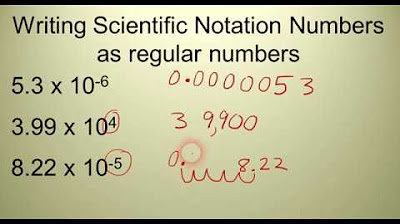2022 | Resumo da Aula | 1ª Série | Matemática | Aula 4 - Notação Científica - I
Summary
TLDRIn this educational video, teacher Eliane explains scientific notation, a mathematical tool for representing very large or small numbers. She demonstrates how numbers like the distance from Earth to the Sun (149,600,000 km) can be written in scientific notation as 1.496 x 10^8 km. The video also covers how small numbers, such as the size of the COVID-19 virus (120 nanometers), can be expressed using scientific notation, like 1.2 x 10^-7 meters. The lesson aims to help students understand the application of scientific notation for both large and small quantities in the international system of units.
Takeaways
- 😀 Scientific notation is a way to express very large or very small numbers in a more manageable format.
- 😀 Numbers in scientific notation are written as a number between 1 and 10 multiplied by 10 raised to an exponent.
- 😀 A rational number in scientific notation can be represented as 'a × 10^n', where 'a' is between 1 and 10, and 'n' is an integer exponent.
- 😀 The distance between Earth and the Sun is approximately 149,600,000 km, which is a very large number that can be written as 1.496 × 10^8 km.
- 😀 When writing large numbers in scientific notation, the decimal point is moved so that the number falls between 1 and 10.
- 😀 For the number 149,600,000, the decimal point moves 8 places to the left to write it as 1.496 × 10^8.
- 😀 Scientific notation helps in representing and simplifying very large numbers, like the distance from Earth to the Sun.
- 😀 Small numbers can also be written in scientific notation using negative exponents.
- 😀 The size of the coronavirus (COVID-19) is approximately 120 nanometers, or 1.2 × 10^-7 meters in scientific notation.
- 😀 A nanometer is equal to 10^-9 meters, making it a very small measurement for viruses or particles.
- 😀 Scientific notation is widely used to simplify calculations and comparisons of both large and small values, especially in science and technology.
Q & A
What is scientific notation?
-Scientific notation is a way to express very large or very small numbers using powers of 10. It is written as 'a × 10^n', where 'a' is a number between 1 and 10, and 'n' is an integer.
What is the condition for the number 'a' in scientific notation?
-'a' must be a number between 1 and 10, but it cannot be 10 itself. This ensures that the number is in a manageable range.
How is the distance between Earth and the Sun expressed in scientific notation?
-The distance is approximately 149,600,000 km. In scientific notation, this becomes 1.496 × 10^8 km.
Why can't the number 14 be used in scientific notation for large numbers like the Earth-Sun distance?
-The number 14 cannot be used because it does not satisfy the condition of being between 1 and 10. Therefore, it needs to be adjusted to a number like 1.496.
How do you represent a very small number, like the size of the coronavirus, in scientific notation?
-The size of the coronavirus is about 120 nanometers. In scientific notation, this is written as 1.2 × 10^-7 meters, where the negative exponent represents a very small value.
What is a nanometer, and how is it represented in scientific notation?
-A nanometer is one billionth of a meter, represented as 10^-9 meters in scientific notation.
How does the decimal point shift when converting a large number into scientific notation?
-When converting a large number to scientific notation, the decimal point is moved to the left. The number of spaces it moves determines the exponent in the scientific notation.
What happens to the exponent when dealing with large numbers in scientific notation?
-For large numbers, the exponent is positive, indicating that the decimal point moves to the left to make the number manageable.
What happens to the exponent when dealing with small numbers in scientific notation?
-For small numbers, the exponent is negative, reflecting the fact that the decimal point moves to the right, making the number smaller.
Why is scientific notation important for understanding measurements in science?
-Scientific notation is important because it allows us to efficiently express and work with very large or very small numbers, which are common in fields like astronomy and microbiology.
Outlines

This section is available to paid users only. Please upgrade to access this part.
Upgrade NowMindmap

This section is available to paid users only. Please upgrade to access this part.
Upgrade NowKeywords

This section is available to paid users only. Please upgrade to access this part.
Upgrade NowHighlights

This section is available to paid users only. Please upgrade to access this part.
Upgrade NowTranscripts

This section is available to paid users only. Please upgrade to access this part.
Upgrade NowBrowse More Related Video

Math Antics - Scientific Notation

Scientific Notation

Introduction to scientific notation | Pre-Algebra | Khan Academy

FISIKA DASAR KELAS X | NOTASI ILMIAH.

NOTAÇÃO CIENTÍFICA | Física, Química 8°, 9° ano , conceito e exercícios | Potencia base 10

IPA Kelas 10 - Notasi Ilmiah & Angka Penting | GIA Academy
5.0 / 5 (0 votes)